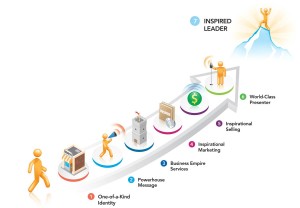
On February 27, 2017, I will celebrate the 10th-year anniversary of the launch of my second business, Inspired Leaders’ Academy. This is a series of excerpts that tells the story of these ten years to help you navigate these same waters more easily and faster!
*
In the last chapter, I told you that my marketing strategy for launching my new business, which then centered around a proprietary public speaking signature program, was to lead a free live “teaser” event. This was educational and highly engaging, but also the opportunity for me to sell my public speaking training. Back then, this was a new strategy; now, of course, you see it online everywhere in webinars.
So, how did I get folks to attend the free teaser—and how is this relevant in today’s world, when so much of this is going on online?
Let me answer that question first. The world of online marketing is so saturated with free webinars, in many ways, they’re becoming invisible, wouldn’t you agree? Smart business owners are seeing the need to get back to basics and meet with people in person again—thus the rise of the MeetUp. In the ten years since I was doing free live events, I’ve seen the progression away from them, beginning in 2009 to back again in 2015. I encourage all new solopreneurs to lead live events, and MeetUp is helpful in that it promotes for you (on a very limited scale!), but my strategy from ten years ago is more valid today than it has been in years.
Essentially, I filled my teaser (i.e. “portal” event) by going to local networking events. My market was business owners and my thesis was that public speaking was–hands down–the best strategy for getting business, and my call to action was, come see how to be better than virtually all other speakers so you stand apart and get sales.
The most important key was providing them with a “ticket” to the event in the form of  a colorful postcard with compelling copy.
a colorful postcard with compelling copy.
I can’t find the February 2007 version, but here’s one from 2009.
On the back, I shared the value of the event in dollar terms ($49) and then said that “with this ticket, you attend for free.” I went to networking events constantly, but by May 2009, word of mouth was working for me.
Getting them in the room is 70% of the challenge—but the rest is what happens in the room. It has to be great or you will lose the sale. You and I have seen many, many, many really bad free talks (whether online or in person) and what’s sad is that the leader doesn’t understand that the content and delivery cost them dearly. Don’t make that mistake: thinking you’re delivery and material are compelling when they’re not!
In my event, I used the very brain-based-learning technology I was “teaching and teasing” and of course, this worked (because these techniques are highly experiential and compelling.) I asked lots of questions; invited people onto stage to be scribes, or to demonstrate. I had everyone verbalizing throughout the event because twice as much brain circuitry is activated when we talk versus just listen. It was fun and it was memorable.
 But it was also new. I was teaching things no one had heard of before. This is the “thought leadership” I now focus on so precisely in my work: you need to illuminate what is wrong with current conditions (in this case, how most people give talks) and how an entirely new methodology (talking to the brains in their audiences) would get them far greater results.
But it was also new. I was teaching things no one had heard of before. This is the “thought leadership” I now focus on so precisely in my work: you need to illuminate what is wrong with current conditions (in this case, how most people give talks) and how an entirely new methodology (talking to the brains in their audiences) would get them far greater results.
And it called them into action in a very concrete way, as I described in detail in Chapter Two. This is a critical distinction, though, and worth repeating. If the rest of the challenge is what “happens in the room,” then it stands to reason that what happens must be effective. Making an offer in no uncertain terms is effective. Harv Eker said often to us, “Never, ever let warm bodies out of the room [without telling them what you have for them because it’s human nature that they will get distracted by the next day].”
When you host your own event, you can do this. I spent 20 minutes on the offer–after over an hour of teaching. And I gave them a heck of a deal. Remember, you are offering something extremely valuable (hopefully!) at a discounted rate that they couldn’t get if they weren’t in the room with you. This is a gift for them. They can choose to take it or not, but you are helping them by giving them a choice to improve their lives. Many don’t see it that way, but that’s only because they have internal conflicts around selling. (I know about this! As I said, I refused to sell for years and consequently hated anyone who tried to sell to me. The two are inextricably linked.) But the truth is, giving an opportunity for someone to achieve a better standard of living is always a gift.
So, there’s how I filled my free portal events and how I made them work for me by giving a high-value, stand-apart experience with an explicit offer.
This is a strategy you want to duplicate.(In subsequent chapters, I’ll tell you how I transitioned to doing this online.) But remember, people want to meet in person more and more now, so be sure that a live talk/seminar is part of your marketing strategy.
*
To conceptualize and structure your next talk/event, download my proprietary design template, The Easy Plugin Design Model. Click here for it.
And today, I am offering 2, 90-minute sessions to help you duplicate my marketing strategy (free live event/talk) as well as conceptualize the content. Because this is my 10th year anniversary celebration, I’m offering my expertise at a discount, which I never do. Just fill out this form now that gets us on a quick free call to ensure you’re ready for this.Go ahead! I promise there’s nothing to lose!





 That weekend, I enrolled in Eker’s Train the Trainer program—and once there, lost my heart to how they worked with audiences, through something called “
That weekend, I enrolled in Eker’s Train the Trainer program—and once there, lost my heart to how they worked with audiences, through something called “ well over a year studying everything I could get my hands on about learning, memory and emotion in the brain.
well over a year studying everything I could get my hands on about learning, memory and emotion in the brain.
 greater in themselves, and greater than themselves, than they ever imagined possible, igniting a change.
greater in themselves, and greater than themselves, than they ever imagined possible, igniting a change.
 Because your inspired thought leader message is your “storefront sign.”
Because your inspired thought leader message is your “storefront sign.” 










 investment “front end” that builds to a more-time/higher-investment “back end.” And you’ve heard the rule that “the profit’s in the back-end, ” which is true. You invest in customers at the front-end, but don’t need to continue getting new customers because they flow naturally into the back-end.
investment “front end” that builds to a more-time/higher-investment “back end.” And you’ve heard the rule that “the profit’s in the back-end, ” which is true. You invest in customers at the front-end, but don’t need to continue getting new customers because they flow naturally into the back-end. You write out that list, from start to completion: what they must learn first, second, third…thirty-fourth…fifty-sixth…until you’ve exhausted everything it will take for them to get to their desired result.
You write out that list, from start to completion: what they must learn first, second, third…thirty-fourth…fifty-sixth…until you’ve exhausted everything it will take for them to get to their desired result.

